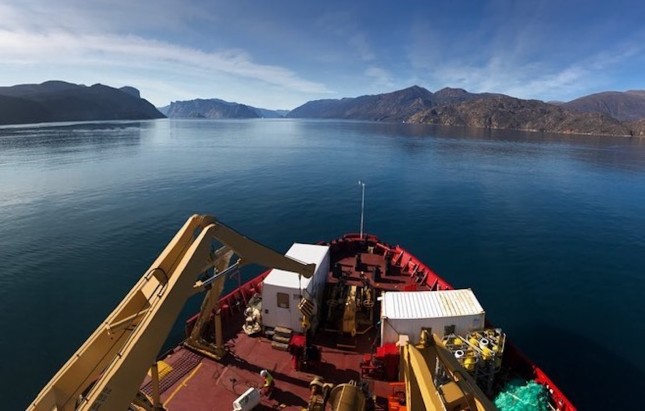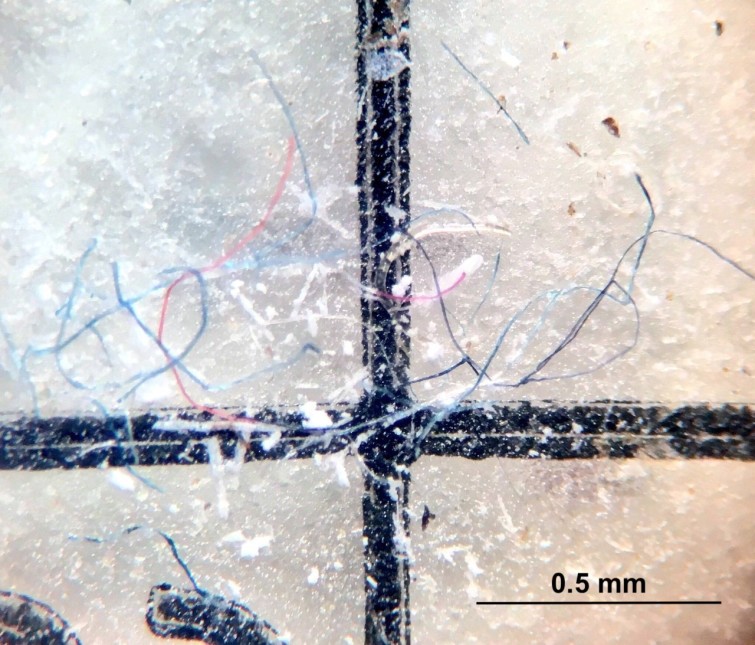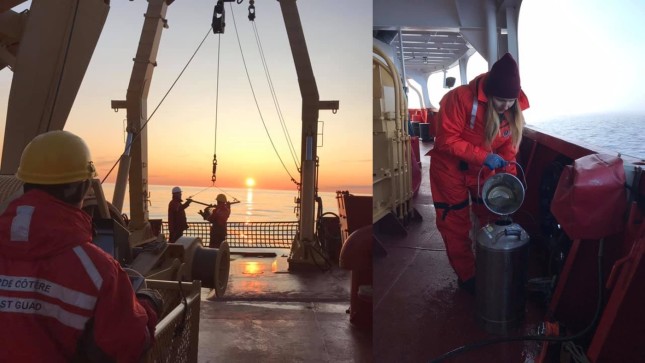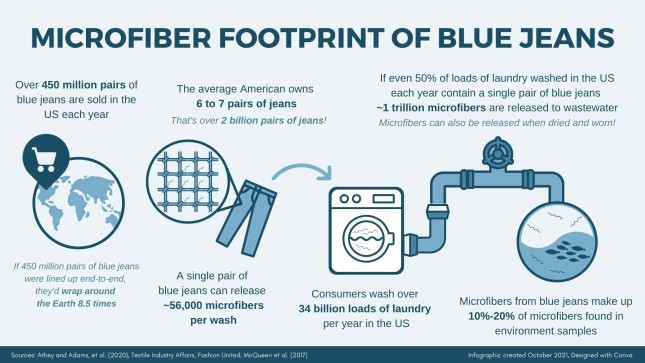
The Arctic is believed to be a pristine environment, far removed from littered city streets and toxic industrial emissions. I study human pollution and I found it hard to believe that my fellow researchers and I would find so much litter out here. It was even harder to believe that what we uncovered closely resembled the contents of my own closet, over 3,000 kilometers (2,000 miles) away in Toronto.
Fast fashion’s macro contribution to microplastics
Plastic is literally the fabric of our society. Over two-thirds of clothing produced each year is woven from threads composed of plastic fibers. We know these materials as our favorite polyester fleece sweatshirts, Spandex or elastane ‘stretchy’ jeans, nylon-polyester blend leggings, acrylic sweaters, and others. Globally, this adds up to approximately 70 million metric tons of plastic per year, about 20 percent of all plastic produced. China plays a central role in the textile industry, as, in 2019, 65 percent of the world’s clothes were manufactured in China.
Sadly, because of the exponential rise and continual domination of mass-produced clothing, known as fast fashion, our closets are bursting with cheaply made garments that are often disposed of within just one year of purchase. As our clothing degrades, the small fibers (also known as microfibers) that make up the threads of our clothing break off when we wear and wash them. Ever pull out a handful of lint from your dryer? That bundle of lint is made up of thousands and thousands of microscopic microfibers. Not only are microfibers present in your dryer and dust, scientists have found them on every continent and major ocean on Earth. Plastic materials can take decades or even centuries to break down in the environment. Natural materials should break down more quickly.

Photo Credit: Microfibers, likely released during clothes laundering, found in wastewater treatment effluent, courtesy of Sam Athey.
Natural fibers, unnatural pollutants
Microfibers are what brought me to the remote Canadian Arctic as part of an Environment and Climate Change Canada (ECCC) research team. We were tasked with documenting microfibers in deep-sea polar environments. The Arctic’s seemingly pristine environment is actually a reservoir for human contaminants, including microplastics and microfibers.
Microfibers can travel thousands of kilometers to remote environments through global air and ocean currents in a process known as long-range transport. Throughout the journey, microfibers settle into sediments, where they are often ingested by marine life. Once ingested, microfibers cause toxic health effects, including impeding a plant or animal’s ability to take up nutrients and produce healthy offspring.
Photo Credit: Scientists working on the deck of the CCGS Amundsen (right). Author collecting surface water samples (left), courtesy of Sam Athey.
On our research expedition, we expected most of the microfibers found in the Arctic to be plastic. However, we discovered that only 11 percent of fibers were made of plastic materials.
A surprising 51 percent of fiber samples were made of anthropogenically-modified cellulose (or plant-based) fibers, such as rayon and cotton. Many of the anthropogenic-cellulose (AC) fibers contain chemical additives, such as dyes and finishing treatments, that are used during textile production. For example, over half of the AC fibers we found were indigo denim—the cotton fibers containing the indigo dye which gives ‘blue’ jeans their name. Through further investigation, we found that most environmental studies on microfibers also found AC fibers, sometimes the modified fibers are more abundant than their plastic counterparts.
While derived from natural materials, AC fibers used in textile production contain a suite of chemical additives that provide the properties we fancy in our clothing, such as stain-resistance, odor-resistance, and fire proofing. In some cases, what is considered 100 percent cotton contains up to 30 percent chemicals by weight. The anthropogenic modification of ‘natural’ fibers using synthetic chemicals may affect how long it takes them to break down in the environment. It may also make these fibers more toxic to animals that accidentally ingest them.
What’s in your wash? Laundering as a source of microfiber pollution
Our research group was led to study the sources of these harmful AC fibers and how they are released into the environment—which is called release pathways. One known way which plastic microfibers are released from synthetic clothing is during laundering. When we wash our clothes, the plastic fibers enter the wastewater, which acts as a channel for microfibers to flow into the environment.
We give significantly less attention to the sources and release pathways for AC fibers . Consequently, in our recent study, we investigated the sources and release pathways of one type of AC fiber: indigo denim. Since the specific indigo dye and cotton are a combination almost exclusively used in denim manufacturing, we measured their release from denim blue jeans during a normal wash cycle.
We found that a single pair of used blue jeans can release approximately 56,000 microfibers in each wash. It is estimated that 34 billion loads of laundry are run each year in the United States alone. If just half of those loads of laundry contain a single pair of blue jeans, more than one trillion microfibers (or approximately 17,000 kg/38,000 lbs of microfibers) may be discharged to wastewater in a single year. That’s the equivalent of roughly 8,500 pairs of jeans!

Photo Credit: Microfiber footprint of blue jeans, courtesy of Sam Athey.
Further, we found indigo denim fibers in wastewater treatment plant effluent, suggesting that wastewater is a release pathway for AC fibers to enter aquatic environments. Yet, the findings portray just one source and one pathway for microfibers to enter the environment. Microfibers can be released from any article of clothing, not just our plastic fleece jackets or our blue jeans! Recent research also shows that microfibers can be released during production, clothes drying, and everyday wear.
To combat consumer concerns over the environmental impacts of fast fashion, companies are making efforts to “go green.” One popular option is by creating garments using recycled plastics and non-plastic materials (e.g., ‘natural’ fibers). While these might seem like promising solutions, they are deceptive marketing practices. In the case of recycled plastic textiles, consumers are led to believe companies are cleaning up plastic from the environment, but recent research shows that clothing created from recycled plastics may release more microplastic fibers than those created from brand new plastic materials.
So, what’s the solution? Should we stop wearing denim and plastic clothing? The answer is not that simple. Our research shows that both ‘natural’ and synthetic textiles shed microfibers. Microfiber research is new, but the growing field is discovering evidence and learning best practices that will help mitigate microfiber pollution. These include employing and supporting the use of microfiber catching technology such as washing machine filters and avoiding Fast Fashion purchases.
Samantha (Sam) Athey (she/her) received a B.Sc. with honors and M.Sc. in Marine Science from the University of North Carolina Wilmington, where she conducted research on the impacts of microplastics in coastal species. Sam is currently a Ph.D. candidate in the Diamond Environmental Research Group and Rochman Lab at the University of Toronto, where she studies the sources, release pathways, and fate of microplastics, microfibers and associated chemical contaminants in the environment.
Sources: The Arctic Institute, Ellen MacArthur Foundation, Environmental Science & Technology Letters, Environmental Science & Technology, Environmental Toxicology & Chemistry, The Fiber Year, Frontiers in Marine Science, Georgian Bay Forever, Greenpeace, Impakter, The Journal of the Textile Institute, Marine Pollution Bulletin, Nature Communications, NewSecurityBeat, Research Journal of Nanoscience and Engineering, Science of the Total Environment, Spectrum News 1, The Textile Exchange, University of Plymouth.
Lead Photo credit: Aboard the CCGS Amundsen somewhere off the coast of northern Baffin Island, courtesy of Sam Athey.
 Further, we found indigo denim fibers in wastewater treatment plant effluent, suggesting that wastewater is a release pathway for AC fibers to enter aquatic environments. Yet, the findings portray just one source and one pathway for microfibers to enter the environment. Microfibers can be released from any article of clothing, not just our plastic fleece jackets or our blue jeans! Recent research also shows that microfibers can be released during production, clothes drying, and everyday wear. To combat consumer concerns over the environmental impacts of fast fashion, companies are making efforts to “go green.” One popular option is by creating garments using recycled plastics and non-plastic materials (e.g., ‘natural’ fibers). While these might seem like promising solutions, they are deceptive marketing practices. In the case of recycled plastic textiles, consumers are led to believe companies are cleaning up plastic from the environment, but recent research shows that clothing created from recycled plastics may release more microplastic fibers than those created from brand new plastic materials. So, what’s the solution? Should we stop wearing denim and plastic clothing? The answer is not that simple. Our research shows that both ‘natural’ and synthetic textiles shed microfibers. Microfiber research is new, but the growing field is discovering evidence and learning best practices that will help mitigate microfiber pollution. These include employing and supporting the use of microfiber catching technology such as washing machine filters and avoiding Fast Fashion purchases.Samantha (Sam) Athey (she/her) received a B.Sc. with honors and M.Sc. in Marine Science from the University of North Carolina Wilmington, where she conducted research on the impacts of microplastics in coastal species. Sam is currently a Ph.D. candidate in the Diamond Environmental Research Group and Rochman Lab at the University of Toronto, where she studies the sources, release pathways, and fate of microplastics, microfibers and associated chemical contaminants in the environment. Sources: The Arctic Institute, Ellen MacArthur Foundation, Environmental Science & Technology Letters, Environmental Science & Technology, Environmental Toxicology & Chemistry, The Fiber Year, Frontiers in Marine Science, Georgian Bay Forever, Greenpeace, Impakter, The Journal of the Textile Institute, Marine Pollution Bulletin, Nature Communications, NewSecurityBeat, Research Journal of Nanoscience and Engineering, Science of the Total Environment, Spectrum News 1, The Textile Exchange, University of Plymouth. Lead Photo credit: Aboard the CCGS Amundsen somewhere off the coast of northern Baffin Island, courtesy of Sam Athey.
Further, we found indigo denim fibers in wastewater treatment plant effluent, suggesting that wastewater is a release pathway for AC fibers to enter aquatic environments. Yet, the findings portray just one source and one pathway for microfibers to enter the environment. Microfibers can be released from any article of clothing, not just our plastic fleece jackets or our blue jeans! Recent research also shows that microfibers can be released during production, clothes drying, and everyday wear. To combat consumer concerns over the environmental impacts of fast fashion, companies are making efforts to “go green.” One popular option is by creating garments using recycled plastics and non-plastic materials (e.g., ‘natural’ fibers). While these might seem like promising solutions, they are deceptive marketing practices. In the case of recycled plastic textiles, consumers are led to believe companies are cleaning up plastic from the environment, but recent research shows that clothing created from recycled plastics may release more microplastic fibers than those created from brand new plastic materials. So, what’s the solution? Should we stop wearing denim and plastic clothing? The answer is not that simple. Our research shows that both ‘natural’ and synthetic textiles shed microfibers. Microfiber research is new, but the growing field is discovering evidence and learning best practices that will help mitigate microfiber pollution. These include employing and supporting the use of microfiber catching technology such as washing machine filters and avoiding Fast Fashion purchases.Samantha (Sam) Athey (she/her) received a B.Sc. with honors and M.Sc. in Marine Science from the University of North Carolina Wilmington, where she conducted research on the impacts of microplastics in coastal species. Sam is currently a Ph.D. candidate in the Diamond Environmental Research Group and Rochman Lab at the University of Toronto, where she studies the sources, release pathways, and fate of microplastics, microfibers and associated chemical contaminants in the environment. Sources: The Arctic Institute, Ellen MacArthur Foundation, Environmental Science & Technology Letters, Environmental Science & Technology, Environmental Toxicology & Chemistry, The Fiber Year, Frontiers in Marine Science, Georgian Bay Forever, Greenpeace, Impakter, The Journal of the Textile Institute, Marine Pollution Bulletin, Nature Communications, NewSecurityBeat, Research Journal of Nanoscience and Engineering, Science of the Total Environment, Spectrum News 1, The Textile Exchange, University of Plymouth. Lead Photo credit: Aboard the CCGS Amundsen somewhere off the coast of northern Baffin Island, courtesy of Sam Athey. A Publication of the Stimson Center.
A Publication of the Stimson Center.











